‘We can’t help patients who are in need’: Deaths continue as regime tightens grip on oxygen
02 August 2021
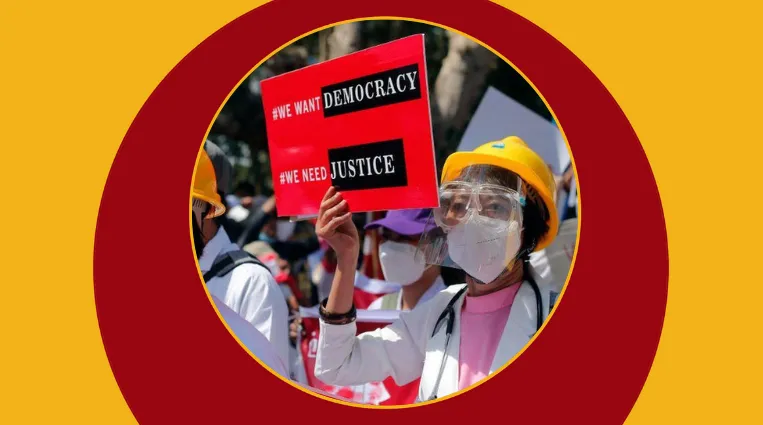
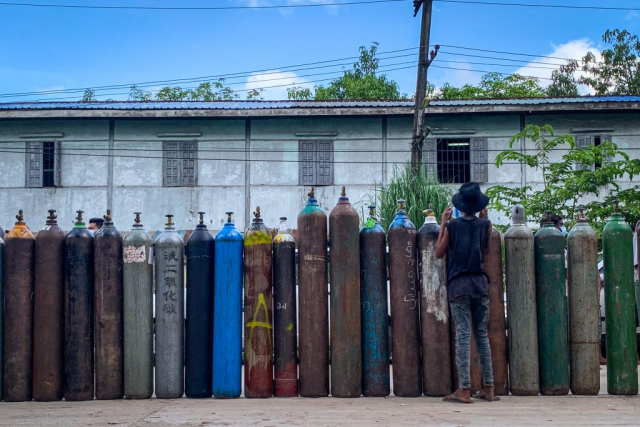
People line up to fill oxygen cylinders outside a factory in Yangon on July 14. (AFP)
New restrictions on the sale and distribution of oxygen to the public have made it harder to treat COVID-19 patients at home and social welfare groups have warned the rules could result in more preventable deaths.
By FRONTIER
When U Maung Ko’s blood oxygen levels began to drop dangerously due to COVID-19, the 42-year-old was lucky enough to secure a bed and treatment at a state hospital.
But when Maung Ko’s father, U Tun Mya, also fell ill on July 4, there was nowhere for him to go; his grandson, Mg Htet Thura Zaw, instead arranged online consultations and medicine for Tun Mya from their Thanlyin Township home.
When Tun Mya’s blood oxygen levels began to drop precipitously on July 7, Htet Thura Zaw began to search desperately for an oxygen cylinder to keep his 72-year-old grandfather alive. He managed to secure occasional oxygen deliveries for his grandfather from charity groups based in downtown Yangon, a one-hour drive away.
On July 11, Htet Thura Zaw received the devastating news his father had died in hospital.
Worse was to come. The next morning, the deliveries of oxygen for his grandfather failed to show up on time because the charity groups were facing longer wait times refill their cylinders. He watched in agony as his grandfather’s blood oxygen level dropped to between 35 and 40 percent. About 10 minutes after Tun Mya died, three oxygen cylinders arrived at the family’s home.
“In 24 hours, I lost both my beloved father and grandfather,” a distressed Htet Thura Zaw told Frontier. “I feel like my future is hopeless without them. But like us, many people in Yangon Region are suffering because of these oxygen shortages.”
Maung Ko and Tun Mya are just two among possibly tens of thousands of victims of Myanmar’s third wave of COVID-19, which has devastated the country over the past six weeks. The official COVID-19 death toll across June and July was 6,000, but many, like Tun Mya, were not counted because they died outside a government health facility.
With an inadequate number of health staff, limited testing, lack of trust in the authorities and low vaccination rate, Myanmar was always vulnerable to a renewed COVID outbreak even without a coup. But the rapid pace with which the virus has spread and the sheer number of cases has created huge demand for oxygen to administer to severely ill patients.
Supplemental oxygen is usually administered when a patient’s oxygen saturation falls below 90pc, but the high demand means that many are being turned away from hospitals until they are far below that threshold. With hospitals overwhelmed, most patients are now receiving treatment in their home, and are reliant on family members and charity groups to find oxygen cylinders and refill them regularly.
Frontier interviewed representatives from fifteen social rescue teams and funeral service groups, who all said that demand for oxygen was only continuing to rise, along with the number of people dying in their homes.
Daw Than Than Soe leads the Shin Than Kwink (Right to Live) Social Rescue and Funeral Services Group, which operates five ambulances in eastern Yangon. She said that from July 1 to 23, at least 150 suspected COVID-19 patients had died while being transferred to hospital by her group.
“As the pandemic goes from bad to worse, the number of patients with hypoxia is increasing day by day,” she said.
Accessing adequate oxygen supplies is only getting more difficult. In mid-July, the regime began restricting sales to the public. From July 28, the regime has ordered oxygen factories to only supply oxygen to those with a recommendation letter from the township “oxygen support committee”, which is run by local officials who answer to the junta.
Social rescue teams and funeral service groups have condemned the restrictions, telling Frontier that it is likely to lead to more people dying in their homes unnecessarily because the regime is not allocating enough oxygen.
Dr Khin Zar Win Pyae, a microbiologist at Nelson Labs in Salt Lake City, Utah in the United States, criticised the bureaucratic delays that prevent patients from urgently seeking care.
Lack of testing and contact tracing meant that Myanmar was likely to see more infections and deaths due to COVID-19, she said.
“People no longer believe that this health care system will protect their parents’ lives. It is a situation of helplessness. So they decide to get treatment at home,” she added.
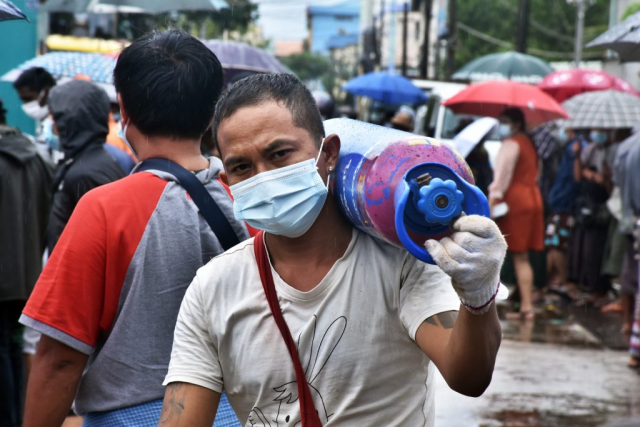
A man carries an oxygen cylinder outside the Matesat factory in South Dagon Township on July 13. (Frontier)
Oxygen crisis
It took the regime weeks to wake up to the crisis.
Senior General Min Aung Hlaing rejected claims of an oxygen shortage at a coordination meeting on COVID-19 prevention, control and treatment in Nay Pyi Taw on 12 July.
“Many people have criticised the oxygen supply in recent days. Actually, we have enough oxygen,” he said. “People are anxious and so they buy it … [but they] should not spread rumours.”
But Dr Zaw Wai Soe, the National Unity Government’s health minister, said the shortage was simple math.
Myanmar has confirmed an average 4,500 cases a day during July, peaking at more than 7,000 cases on July 14. But limited testing and an alarmingly high positivity rate – around 35 percent of all tests have come back positive – means the number is likely many times higher.
Zaw Wai Soe said that about one-fifth of patients are likely to become critically ill and require oxygen. A severe COVID-19 patient may need two oxygen cylinders a day over the course of 10 days to recover.
During the second wave that broke out in August 2020, Zaw Wai Soe served as vice-chair of the committee coordinating COVID-19 response in Yangon. He said officials calculated the number of oxygen cylinders required based on the number of cases, and ensured there were enough available each day.
“The man who said we have enough oxygen may not know the calculations. Probably because he was advised by some good-for-nothing doctors,” Dr Zaw Wai Soe told Myanmar Now on July 18.
Even as Min Aung Hlaing claimed there was no shortage, the junta was taking steps to control how oxygen factories distribute supplies to the public.
At a press briefing in Nay Pyi Taw on July 12, Deputy Minister of Information Major-General Zaw Min Tun admitted that the government was prioritising oxygen supplies to hospitals and clinics, which has made it harder for private individuals to get oxygen on their own. The deputy minister also said that officials had received complaints about price gouging and consumer hoarding.
“First, the reason we put these restrictions in place is because we discovered scams on the internet. Some people are committing fraud, pretending to provide services refilling oxygen supplies, and we received complaint letters,” he said.
“Second, there are many cases of unnecessary use of oxygen supplies. For those who actually need oxygen, they can obtain refills with recommendation letters from local healthcare staff,” Zaw Min Tun added.
In Yangon and other major cities, these restrictions have left people scrambling to secure oxygen supplies for sick relatives. Many are posting on social media about relatives who are in need of oxygen – tragically, these posts are often updated advising that the person in need has died.
In July, Frontier interviewed relatives of 15 suspected COVID-19 patients who were being treated at home and relying on private oxygen supplies because they were not admitted to government hospitals and COVID treatment centres. Among the 15 patients, three recovered, seven died of hypoxia and five are still on oxygen.
Shortages are common in other hard-hit cities such as Mandalay, Mawlamyine in Mon State and Kalay in Sagaing Region, according to Frontier’s interviews with social rescue teams and funeral service associations across the country.
“Oxygen shortages are still happening in Mandalay. We help and donate oxygen to on average 40 residents a day in our township out of 100 requests we receive,” said an official from the Mandalay-based Payaheta Darri charity in Chan Aye Thar Zan township, who requested anonymity citing fears of reprisal.
The restrictions have prompted international observers to accuse the regime of “weaponising” COVID-19 against the public, most of whom oppose its rule.
“With the oxygen, they have banned sales to civilians or people who are not supported by the SAC, so they’re using something that can save the people against the people,” Ms Yanghee Lee, the former United Nations special rapporteur on human rights in Myanmar, and a founding member of the Special Advisory Council for Myanmar, recently told AP.
Controlling the supply
Through most of July, more than 3,000 people from across Yangon gathered each day at three privately run factories in South Dagon – Naing Family, Ayar San and Matesat – that have been refilling oxygen cylinders.
When Frontier visited the Matesat factory on July 12, U Thant Zin from Thingangyun Township was lining up to refill oxygen cylinders for his grandmother.
“She needs oxygen every day, so I come here to the oxygen plants in South Dagon Industrial Zone and line up. It takes a whole day to refill two oxygen cylinders,” he said.
Although there have been confirmed reports of the authorities limiting oxygen sales to the public, the factories in South Dagon were able to continue sales through most of July.
“The junta’s security forces are not preventing us from refilling oxygen for the public at the moment. We provide refills every day, but the number of people who need oxygen increases day by day,” an official from the Matesat factory, who requested anonymity, said at the time.
However, that changed on July 28, when township General Administration Departments ordered factories in Yangon to provide oxygen only to those with a recommendation letter from local authorities. As a result, the queues at oxygen plants have largely disappeared – most plants have put up signs explaining they are no longer selling oxygen to the public.
On July 20 the regime established township and ward-level “oxygen support committees” to issue recommendations and manage the provision of oxygen. The township committees are led by the township administrator and include other officials, community leaders and representatives of social welfare groups.
Anyone who needs oxygen has to apply for a recommendation from their ward administrator by submitting a raft of documents, including the patient’s Citizenship Scrutiny Card, their household list, and photos of the patient, their oxygen level and the number of cylinders they have.
Once approved, those in need are given a regular allocation of oxygen by the ward committees.
Although it is relatively straightforward to get the recommendation for those possessing the proper documentation, both social welfare groups and individuals told Frontier they opposed the new distribution system.
Frontier interviewed residents from North Okkalapa, Thingangyun, South Dagon and Thaketa who had received recommendation letters and all said the committees were not distributing enough oxygen.
The ward committees are refilling only one 10 or 15 litre cylinder a day per person, and all five people said they were not actually filling the cylinders to full capacity.
“I need four 40L cylinders for my friend … so I have to get more from oxygen donation charity groups,” said U Toe Toe Naing from North Okkalapa Township. “Getting oxygen for patients is getting harder and harder. There are likely to be more deaths because of the shortages.”
Five social welfare and funeral service groups in Yangon confirmed to Frontier that the oxygen support committees are only providing them with enough oxygen to fill two 40-litre cylinders a day.
“Two cylinders is not even enough for us to transport patients in our ambulance,” said an official from a social welfare group in North Okkalapa Township. “These days, even social rescues and funeral services groups are struggling to get oxygen – we can’t help patients who are in need.”
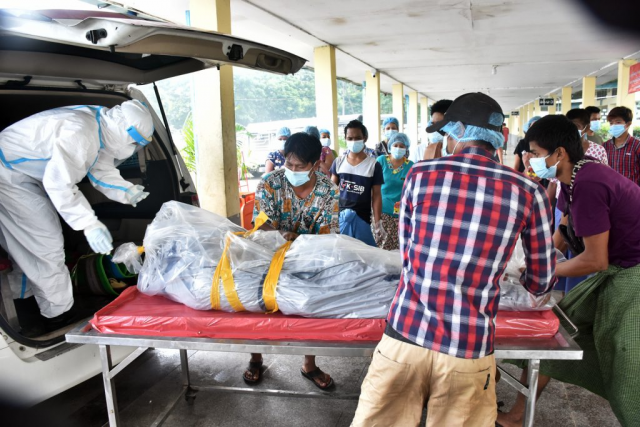
Volunteers and staff unload a body at the crematorium in Yay Way cemetery in Yangon’s North Okkalapa Township on July 28. (Frontier)
Overwhelmed health care system
Under orders issued by the junta in early July, close contacts of confirmed COVID-19 patients and those with COVID-19 symptoms must inform their respective township health departments or hospitals.
If they test positive, confirmed cases must then report to their respective township, region or state health committee, and they will be sent to the relevant public hospital or COVID-19 treatment centre at the discretion of committees managing hospital admissions.
At a COVID-19 coordination meeting on July 18, junta leader Min Aung Hlaing said that 1,934 quarantine centres for about 69,800 patients have been prepared, as well as 1,114 additional locations that can accommodate nearly 46,000 patients. Care is also available at public hospitals, the senior general claimed.
The junta’s announcement also states that patients with severe COVID-19 and emergency patients can go directly to the nearest public hospital or COVID-19 treatment centre, and that it is still possible to be admitted to a state facility for treatment.
“If the patient is not severely ill, they may have to wait for a bed in the hospital. Sometimes it can take a while,” Dr Myat Thu Win, head of the medical services department in South Dagon township, told Frontier on July 18. “In severe cases, we immediately give them a referral letter … These patients can be admitted to the hospital the same day.”
But in reality, COVID-19 treatment centres and government hospitals are already well over capacity and are turning away or sending home patients with dangerously low oxygen levels, according to staff from charities and family members of COVID-19 patients in Yangon and Mandalay.
“Many hospitals lack health staff and have no empty beds,” said Than Than Soe of the Shin Than Kwink (Right to Live) Social Rescue and Funeral Services Group.
She said her teams had transferred dozens of seriously ill patients to hospitals but been forced to take them home again because no beds were available. Around one-third died in the ambulances on the way home, she said.
Thaketa township resident Daw Thidar Soe, elder sister of COVID-19 patient Daw Tin Tin Nwe, 45, told Frontier that North Okkalapa Hospital had refused to admit her sister on July 7, even though her oxygen saturation was below 60pc.
“The doctor told me to contact our township medical officer to request admission to the hospital and we would have to wait. We couldn’t know exactly how many days it would take so I decided on home treatment and found private oxygen supplies for my sister,” said Thidar Soe, adding that her sister recovered by July 12. “The healthcare system just isn’t coping with the number of COVID-19 patients.”
Microbiologist Khin Zar Win Pyae said that even if hospitals are full, the Ministry of Health and Sports should be conducting teleconsultations with patients who are receiving treatment at home. “And I would like to advise patients who use oxygen treatment at home to consult with qualified medical doctors before using it in order to avoid unnecessary side-effects.”
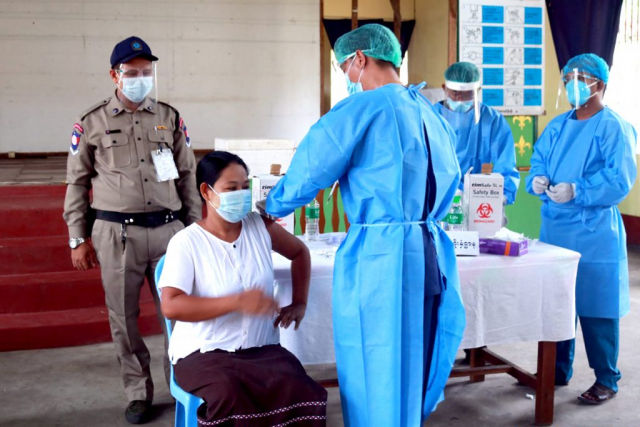
Health authorities vaccinate an inmate at Yangon’s Insein Prison on July 28. The majority of health workers remain on strike in protest at the February 1 coup. (AFP/Myanmar News Agency)
A divided response
The February 1 coup is a major reason that the health system is so chronically underprepared. It prompted tens of thousands of health workers to join the Civil Disobedience Movement, and significantly slowed an already limited vaccination program. Government health staff have refused to work under the military regime, and many of the volunteers who were the backbone of the National League for Democracy government’s COVID response have shunned the junta.
Although they continue to try and provide healthcare to those in need, the regime has sought to stop them from providing medical treatment and have arrested CDM leaders.
At a coordination meeting on July 23, a visibly frustrated Senior General Min Aung Hlaing urged striking doctors and nurses who joined the CDM to return to work and alleviate the staff shortages.
“This is a social issue! This is a national issue,” he said. “I appeal again! I want to urge all healthcare professionals to cooperate.”
The “appeal” has been largely ignored by health professionals who have joined the CDM.
“The junta blames CDM doctors for failing to control the COVID-19 epidemic. But the military council has arrested, killed and imprisoned health doctors and volunteers,” said one health professional supporting the CDM in Mandalay who requested anonymity for security reasons. “When they return to the barracks, the doctors will spontaneously return to the hospitals.”
Although it has been unable to address the manpower shortage, the regime has taken steps to increase supplies of oxygen, by making it easier to import liquid, medicine and medical equipment, such as oxygen concentrators. It has also been working to ensure that access to the increased supply requires interfacing with regime officials.
On July 15, the first truckloads of liquid oxygen began crossing the border from Thailand, depositing their life-saving cargo at public hospitals in Yangon.
Meanwhile, the United Nations announced on July 19 that it would step up its response to the COVID-19 outbreak and would work to alleviate the oxygen shortage by procuring oxygen concentrators and other equipment.
On July 21, the European Union expressed sympathy to all people of Myanmar who have lost their loved ones in the pandemic and committed to doubling efforts with the Global Fund, COVAX, and other partners that can support medical care, oxygen supplies, testing and vaccinations.
The regime has also issued an appeal of sorts for international support, with Min Aung Hlaing telling a “coordination meeting to beef up cooperation with the international community,” and that Myanmar should seek money from a COVID-19 response fund set up by ASEAN. Efforts were being made to work with ASEAN “and friendly countries”, the state-run Global New Light of Myanmar quoted him as saying.
The National Unity Government, meanwhile, has pledged to begin rolling out a vaccination programme of its own, targeting to immunise 20 percent of the population by working with the health teams of ethnic armed groups, and possibly international organisations, but it has provided few further details about the programme.
In the meantime, local charities continue their struggle to keep patients alive.
“Even charity groups like us have now run out of oxygen. From morning until night, we wait for the chance to refill oxygen,” said Than Than Soe of Shin Than Kwink.
She said her organisation’s supplies are never enough to meet demand. “It’s devastating when people cry mournfully and ask for oxygen from us to help their family members and relatives who need it,” she said. “Of course I want to give them oxygen – but I simply can’t help.”
Original Post: Frontier Myanmar
Announcements
28 February 2025
Asian NGO Network on National Human Rights Institutions , CSO Working Group on Independent National Human Rights Institution (Burma/Myanmar)
Open letter: Removal of the membership of the dis-accredited Myanmar National Human Rights Commission from the Southeast Asia National Human Rights Institution Forum

Progressive Voice is a participatory rights-based policy research and advocacy organization rooted in civil society, that maintains strong networks and relationships with grassroots organizations and community-based organizations throughout Myanmar. It acts as a bridge to the international community and international policymakers by amplifying voices from the ground, and advocating for a rights-based policy narrative.